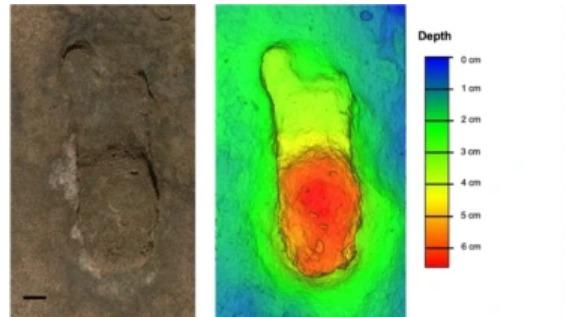In 2022, during archaeological work which aimed to study the mobility of large rock blocks in Morocco, in Larache, an international research team led by Dr. Mouncef Sedrati (teacher-researcher and director of the Geo-Ocean laboratory at the University Bretagne Sud in Vannes in France) made a sensational discovery.
85 footprints of homo sapiens dating from the Late Pleistocene and around 100,000 years old were found near the coast, on a rocky surface of around 2800 square meters.
A study was carried out and then published in January 2024 on the Scientific Reports website (Nature portfolio) by the Université Bretagne Sud in France, in partnership with Moroccan, German and Spanish Universities.
She says they are the oldest known human footprints from North Africa and the southern Mediterranean.
These prints were left by at least 5 individuals, children, adolescents and adults.
“They are mainly oriented towards the sea and give a striking image of what the search for marine resources by Homo Sapiens who inhabited or skirted the Larachoise coast could probably be
,” notes the study.
To identify the profile of the “Marcheurs de Larache”, the images and measurements of the footprints were subjected to a morphometric analysis.
The results allow us to estimate that these prints belong to individuals of different ages, children and adults, with a strong variation in size (between 121 and 189 cm).
The research has only just begun
These footprints have escaped the wear and tear of time and natural elements thanks to “a covering by fine sediments during a phase of low swell conditions combined with a period of low tidal range” explains Dr. Mouncef Sedrati.
However, today they are threatened by rising sea levels and storms.
Dr. Mouncef Sedrati told Medias 24:
“In the short term, more footprints will likely be discovered as the sediments erode.
It would therefore be interesting to follow this erosion and discover new complementary traces, which would allow us to obtain more details on the Homo Sapiens group which roamed or inhabited this Larach coast."
The researcher would like to collaborate with Moroccan teams and the National Center for Scientific and Technical Research and other institutions to develop a joint research project in the region:
“Other traces remain to be discovered and, in general, all the The human and social history of this group of Homo Sapiens remains to be told.”

